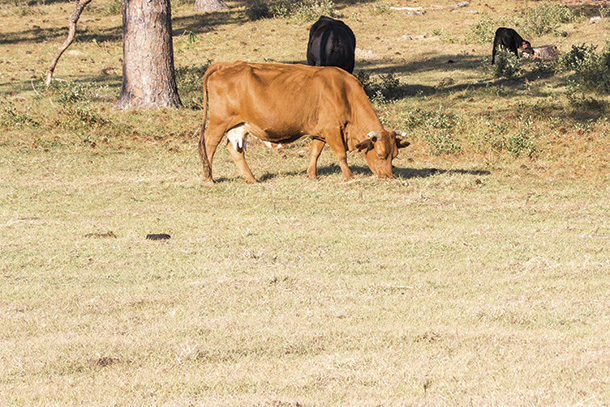We are a couple of years into drought now. Drought is a naturally occurring cycle, but man-made droughts caused by poor grazing practices are unfortunately highly common. When these two forms of drought collide, it compounds problems. There are steps to be taken that are free or relatively cheap to alleviate some issues.
The most appealing option would be to sell all your cattle and buy a condo on Maui. Done, problem solved, the end. However, since that is probably not going to happen, here are some steps you can take to navigate your way through a dry grazing season.
Plan for drought long term and keep vigilant
1. Determine a sustainable level of forage production for the ranch. This process essentially correlates precipitation levels with production (it varies with climate, forage species, etc). Never, never (did I say never?) use average annual precipitation. Why? We are currently only at 20% of the average, and we are below-average 60%-75% of the time, depending on location. If we plan according to average, we will be perpetually overstocked except in those exceptional years of high rainfall. My method is to use the previous 20 years of precipitation data for the area and then use the average precipitation that falls within the first standard deviation from the mean. My brain hurts when I think of statistics classes, but by doing this, it keeps us focused on a much more reasonable precipitation prediction on the long term by throwing out the roughly one third that is the extreme high and the extreme low. This is a quick and easy task in Excel for those of us who are spreadsheet freaks and geeks. Everyone has their own method; this one is mine, and I’ve found it to work.
2. I stock the base herd to 85% of the average precipitation that falls within the first standard deviation and use yearlings or bring in custom-grazing cattle to fill the voids on good years. This allows for more predictability with flexibility to take advantage of good years while being hurt less in bad years.
3. Regularly take a forage inventory. Always know how many months of feed are on the ground and in the stack. Environment determines frequency of measuring inventory. High-growth areas will require more-frequent monitoring. Always have a trigger point for destocking. That is to say, “If I don’t have x amount of forage on the ground by this date, or x amount of precipitation by this date, I will destock by x amount.” It will look different for every operation, and there is no one size fits all. Most cow/calf operations wait too long to destock. Cow/calf producers often get attached to cows and make destocking an emotional decision rather than a financial one.
4. Stock cattle as densely as possible and move them as frequently as possible. This will keep land at rest and forage growing as long as possible, and it gives the greatest recovery time after a grazing event. Soil will hold more moisture and stay cooler as well.
Responding to drought triggers
1. Now you’re in drought. I heard it once said that rain begets rain and drought begets drought. When I’m in a drought, I start looking at the last three years of precipitation and forecast future precipitation on the current trend. If we normally get 14 inches of rain and for the last three years we’ve been dropping an inch, then I plan on that trend to continue and stock the base herd at 85% of that level. If I have to destock some at that time, I do it. This is short-term drought planning versus long term. Both need to be reviewed on a regular basis or we get caught with our pants down.
2. Inventory feed more regularly and keep a very tight eye on it, and destock at your trigger point, don’t delay. Beat the market drop everyone else gets stuck in. Last fall we preg checked early and sent our culls into town six weeks before normal. Did we lose some weight on some calves by weaning early? Sure, but we saved grass for two truckloads of cows that was worth $90 per animal unit month at the time. The cows beat the rush and sold for $300-per-head more than if we had waited six weeks to ship them. It doesn’t take a mathematician to figure out that we came out way better financially by this move.
3. Tighten your pasture management. In pasture settings, use electric fencing to tighten pastures (making them smaller) and move every day instead of every three, or twice a day instead of once a day. In range settings, maybe herd cattle daily to a fresh area of the pasture and settle them on that area for the day. Everything you can do to decrease selective grazing, do it.
4. Stay away from protein supplements. If cattle need protein, give it to them; don’t short them what they need. But what I find more often in drought conditions is salesmen who say, “If you put out some protein, they can digest more feed and utilize more feed sources.” This makes sense at first, but there is a shortage of feed. If feed is scarce and cattle eat more protein, their forage intake goes up, of course, so we burn through already scarce feed that much faster. This is essentially pouring gas on the fire. Decreasing forage demand through early weaning or destocking is almost always more financially beneficial. Don’t throw unnecessary inputs into an already potentially costly situation. ![]()
The opinions expressed are those of the author and not of Progressive Cattle.
PHOTO: Take the necessary steps to stay prepared for when pastures run dry. Photo by Lynn Jaynes.
-
Billy Whitehurst
- Makale Livestock
- Whitehall, Montana
- Email Billy Whitehurst









